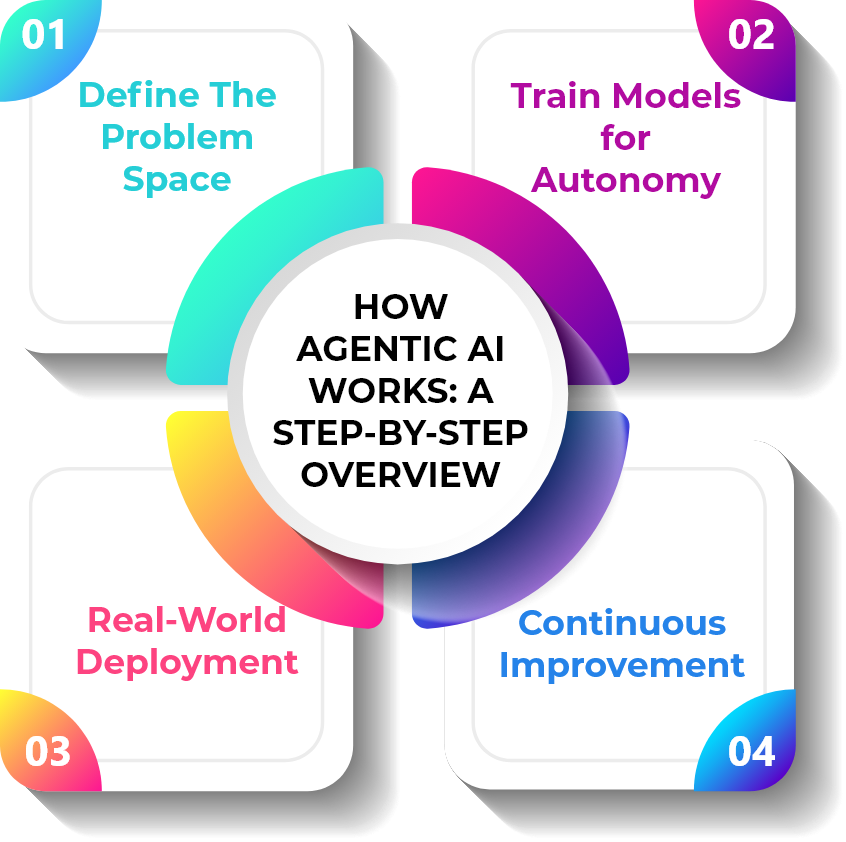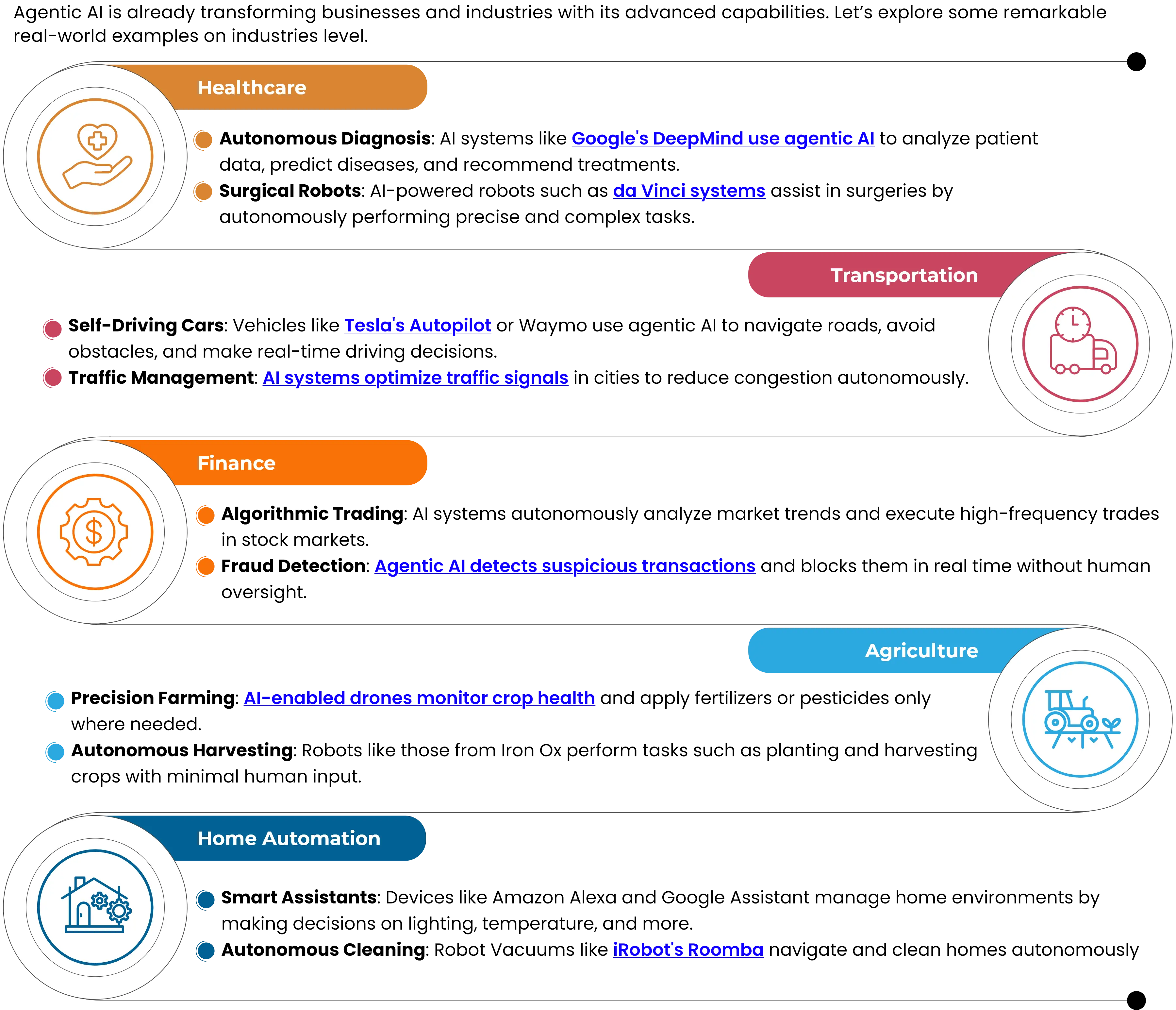Introduction
Agentic AI is rapidly emerging as a transformative technology that takes artificial intelligence beyond static models and into adaptive, goal-oriented systems. It is also predicted to be one of the defining trends of 2025. Before Agentic AI becomes a buzzword, let’s explore the fundamentals of Agentic AI, how it works, why it’s a game-changer, and what you need to consider when implementing it in real-world applications.
What is Agentic AI?
Among the latest breakthroughs is Agentic AI that takes autonomy and decision making to a new level. Before diving deep into agentic AI, let's understand what agentic AI is and why it's called agentic AI. In simple terms, Agentic AI refers to AI systems that behave like agents – entities capable of perceiving their environment, making decisions, and taking actions to achieve specific goals.
The term “agentic” derives from the word “agent,” specifying the system’s ability to operate autonomously and adapt over time. With the increasing demand for smart and capable AI from industries, Agentic AI is becoming a transformative technology, revolutionizing how we solve problems and interact with intelligent systems. This shift from static AI models to adaptive, goal-directed AI systems is revolutionizing various industries—from robotics and healthcare to finance and agriculture.
Core Components of Agentic AI
At its core, Agentic AI consists of several interconnected components.
Perception
It gathers, analyzes, and interprets data from its surroundings using sensors, cameras, or APIs.
Example: Self-driving cars rely on radars, lidar, and cameras to detect traffic patterns and obstacles.
Reasoning
This is where the system makes decisions. It evaluates the collected data, weighs possible outcomes, and determines the best course of action.
Example: A drone deciding whether to spray fertilizer or pesticides based on real-time crop health data.
Action
Once a decision is made, the AI executes an action, such as sending a notification, activating machinery, or rerouting a vehicle.
Example: An AI-powered traffic system adjusting signal timings to prevent congestion in busy intersections.
Feedback and Learning
- Through machine learning algorithms, the system evaluates the outcomes of its actions, identifies errors, and refines algorithms over time and uses this information to improve future decisions.
- Example: A recommendation system updating its model after user interactions to better predict preferences.
How Agentic AI Works: A Step-by-Step Overview
Now, we know what Agentic AI is and its core components. Let’s have a look at how Agentic AI works step by step.

Define the Problem Space
Clearly outline the objectives or metrics (KPIs) the AI system should achieve, whether it’s improving efficiency, making predictions, or managing resources.
Train Models for Autonomy
Use relevant datasets to train AI models that interpret environments, make decisions, and execute actions with minimal oversight.
Real-World Deployment
Test the trained models in controlled environments or simulations, then roll them out into production or real-world scenarios incrementally.
Continuous Improvement
Use feedback loops and continuous monitoring to adapt the AI’s behavior to changing conditions, ensuring optimal and consistent performance.
Additional Considerations & Emerging Developments
Multi-Agent Systems and Communication
- In many industries, multiple AI agents may need to collaborate or negotiate. Designing communication protocols ensures these agents can work together effectively (e.g., coordinating drone fleets in agriculture).
Edge Computing
- Instead of relying solely on cloud infrastructures, some Agentic AI solutions are deployed on edge devices (e.g., smartphones, IoT sensors), reducing latency and improving response times.
Ethical and Regulatory Frameworks
- With autonomous decision-making comes responsibility. Ensure that your AI agents comply with data protection laws (GDPR, HIPAA, etc.) and consider ethical guidelines for transparency and fairness.
Human-AI Collaboration
- Agentic AI need not replace human operators entirely; in many cases, it augments human decision-making. Designing systems that facilitate seamless collaboration can yield the best outcomes.
Implementing Agentic AI in Real-World Systems
Agentic AI implementations are possible with strategic planning. Here are the key steps:
Choose the Right Tools and Frameworks
- TensorFlow or PyTorch for deep learning, OpenAI Gym for reinforcement learning, and MATLAB/Simulink or specialized platforms for agent-based modeling.
Define Goals and KPIs
- Quantify expected outcomes (e.g., reduce costs by 20%, cut machine downtime by 15%) so you can measure ROI effectively.
Test in Controlled Environments
- Validate performance via simulations or pilot studies before full-scale deployment to mitigate risks.
Address Challenges
- Factor in ethical concerns, data privacy, regulatory compliance, and budget constraints during the planning stage. Conduct thorough risk assessments to ensure responsible deployment.
Plan for Scalability
- As your needs grow, ensure that the system’s architecture (cloud vs. on-premises vs. edge) can handle increased data volumes and evolving requirements.
Agentic AI with Examples

Advantages and Limitations of Agentic AI
Advantages of Agentic AI
Increased Efficiency
Agentic AI automates repetitive tasks and makes decisions faster than humans, significantly improving productivity.
Scalability
It can easily be deployed across various domains, from healthcare to finance, adapting to specific needs.
Enhanced Decision-Making
By analyzing large datasets and learning from them, Agentic AI provides accurate and data-driven insights.
Cost Reduction
Over time, autonomous systems reduce operational costs by minimizing errors and streamlining processes.
Personalization
In industries like e-commerce and entertainment, Agentic AI customizes user experiences, fostering customer satisfaction and loyalty.
Limitations of Agentic AI
High Initial Investment
Developing and implementing Agentic AI systems requires significant financial resources and technical expertise.
Ethical & Privacy Concerns
Autonomous decision-making raises questions about accountability, data privacy, and the potential misuse of AI systems.
Data Dependence
Agentic AI is only as good as the data it’s trained on. Poor quality or biased data can lead to flawed decision-making.
Complexity in Development
Building AI agents that can learn, adapt, and act autonomously involves intricate programming and advanced algorithms, posing a challenge for developers.
Unpredictability
While adaptability is an advantage, it can also lead to unintended consequences if the AI behaves in ways its creators didn’t anticipate.
The Future of Agentic AI: Trends and Innovations
Advanced Agent-Based Modeling
Expect more sophisticated multi-agent simulations for smart cities, industrial automation, and logistics operations.
Smarter Cities
Autonomous decision-making will optimize everything from energy distribution to public transportation and waste management.
Quantum & Next-Gen AI
Breakthroughs in quantum computing and novel algorithms will push Agentic AI toward new performance benchmarks.
Explainable and Trustworthy AI
Researchers are developing methods to make AI decisions more transparent, fostering trust and regulatory acceptance.
Conclusion
Agentic AI represents a significant leap in the evolution of artificial intelligence—shifting from static, rule-based systems to dynamic, goal-oriented agents capable of sensing, deciding, acting, and learning in real time. Its transformative potential spans healthcare, transportation, finance, agriculture, and more. Yet, implementing Agentic AI responsibly requires careful attention to ethics, data governance, and robust design principles.
Are you ready to embrace the future of Agentic AI and harness its potential to reshape your industry? Start by defining your goals, choosing the right technologies, and planning for continuous improvements.
For AI Services, partner with Kalpita Technologies.
This article was originally published on Kalpita Technologies.
References: